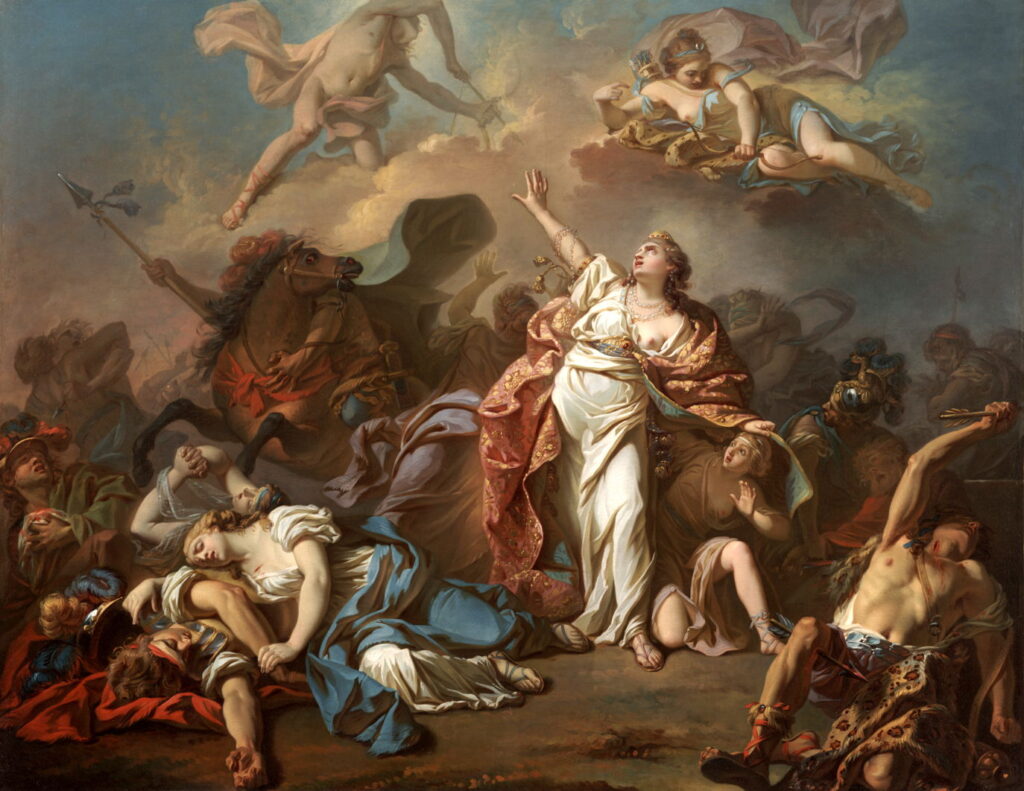Changing Paintings: 25 The slaughter of Niobe’s children

After he told the story of Arachne being turned into a spider for her pride, Ovid turns to Niobe, who had known Arachne in the past.
Niobe, daughter of Tantalus, a son of Jupiter, had married well, to Amphion, King of the ill-fated city of Thebes. When the women of Thebes are called to worship the goddess Latona (Greek: Leto), Niobe tells them that she’s more worthy of their worship than Latona. Reeling off a succession of reasons including wealth and family, she makes her children a part of her claim, as she has seven sons and seven daughters, against Latona’s two, who just happen to be the gods Apollo and Diana, claiming Latona was ‘almost childless’ in comparison.
Latona is outraged by Niobe’s arrogance, and tells her children Apollo and Diana to punish Niobe.
Apollo finds Niobe’s seven sons practising athletics, and one by one, starting with the oldest, kills them with his arrows. Ovid names each in turn, and describes their falling graphically, with bits of lung being pulled from chest wounds, for example. News of this slaughter quickly reaches Niobe; Amphion, her husband, ends his grief by burying a dagger into his own chest. Niobe embraces the corpses of her dead sons, then taunts Latona again, still claiming her own triumph.
With Niobe’s seven daughters putting their brothers into coffins, Diana starts killing the women with her deadly arrows. Six are killed swiftly, before Niobe pleads unsuccessfully for the life of her last child. The mother then crouches beside the bodies of her husband and their children. The weeping Niobe is transformed into marble on a mountain peak, dripping water to form the River Achelous.
Niobe’s children, the Niobids, have long been a popular subject for the sculptor, and in turn their sculptures have often been the inspiration for figurative drawings and paintings. Despite, or possibly because of, the grim carnage in this story, it has been a popular subject for paintings, and has attracted talented history painters.
Jacopo Tintoretto (c 1518-1594), Niobe and her Children (1541-42) (E&I 22), oil on panel, dimensions not known, Galleria Estense, Modena, Italy. Image by Sailko, via Wikimedia Commons.
Jacopo Tintoretto’s Niobe and her Children from 1541-42 tells of this tragic consequence of human pride. The arrogant and boastful mother Niobe is shown in a dark green dress, holding her arms up to Apollo and Diana above, who are raining their arrows down and killing her children around her. Although Niobe’s arms aren’t quite accurately projected and too large, they dominate the painting dramatically.
Abraham Bloemaert (1564–1651), Apollo and Diana Punishing Niobe by Killing her Children (1591), oil on canvas, 203 x 249.5 cm, Statens Museum for Kunst (Den Kongelige Malerisamling), Copenhagen, Denmark. Wikimedia Commons.
Abraham Bloemaert’s Apollo and Diana Punishing Niobe by Killing her Children (1591) is a fine example of this story told clearly. In the foreground, the corpses of most of the sons are laid out, with arrows impaling them. Just to the left of centre, still wearing her crown with pride, is Niobe herself. Around her are the marble-white bodies of her daughters, with Diana up in the clouds at the upper right, still loosing her arrows to complete the massacre.
Richard Wilson (1714–1782), The Destruction of Niobe’s Children (1760), oil on canvas, 166.4 x 210.8 cm, Yale Center for British Art, New Haven, CT. Wikimedia Commons.
Richard Wilson is better-known as an early and innovative landscape painter, and the founding father of painting in Wales. The Destruction of Niobe’s Children (1760) is a classical history-in-landscape, with a bolt of lightning in the centre far distance, a chiaroscuro sky, and rough sea below. He shows the story at an earlier point, when Apollo is still killing Niobe’s sons. The god is at the top of a steep bank on the left, with Niobe among her children down below.
A dozen years later this story was the subject for the prestigious Prix de Rome in 1772.
Pierre-Charles Jombert (1748-1825), The Punishment of the Arrogant Niobe by Diana and Apollo (1772), oil on canvas, 40.6 x 32.8 cm, École nationale supérieure des Beaux-Arts, Paris. Wikimedia Commons.
The winner was Pierre-Charles Jombert (1748-1825), with The Punishment of the Arrogant Niobe by Diana and Apollo (1772). He puts Niobe in the centre, as might be more typical of a religious story, trying to shelter one of her younger daughters from the raining arrows. Apollo and Diana are up in the clouds, Diana taking care in her marksmanship. Around Niobe’s feet are the bodies of her sons, arrows protruding from them in witness to Apollo’s deadly skills.
Jacques-Louis David (1748–1825), Apollo and Diana Attacking the Children of Niobe (1772), oil on canvas, 120.7 cm x 153.7 cm, Dallas Museum of Art, Dallas, TX. Wikimedia Commons.
That was the second year that Jacques-Louis David (1748–1825) had entered the Prix de Rome, and he was so shocked that his Apollo and Diana Attacking the Children of Niobe (1772) wasn’t the winner that he went on hunger strike for a couple of days. He was eventually persuaded to resume eating and painting, failed a third time the following year, but was finally successful in winning the prize in 1774.
David’s canvas is a mass of dead bodies, sheltering daughters, horses, carnage, and death. Amid all this Niobe stands, her right hand held up to the gods, imploring them to spare her last remaining daughter. Apollo still seems busy with his bow, although Diana seems to have finished her task.




